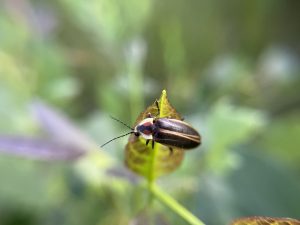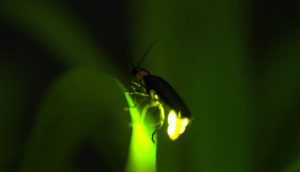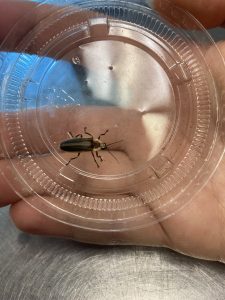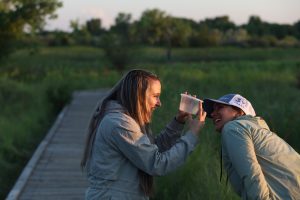As firefly populations decline at alarming rates, Butterfly Pavilion aims to understand the husbandry and rearing of fireflies with our Firefly Lifecycle Project—a conservation initiative focused on collecting and rearing native fireflies into adulthood.
Populations of these bioluminescent beetles are scattered in localized pockets of wetlands around Colorado. In these wetlands, fireflies act as predators of other invertebrates like snails and earthworms, and as prey for birds, reptiles, and amphibians. With wetlands being lost to development and water and light pollution, it is important that we study these populations and how to preserve our native wetland habitats. Since 2019, Butterfly Pavilion researchers have collected a small number of wild adult fireflies each summer. Our researchers then rear the offspring of these adults, studying how different environmental cues affect their development in hopes of successfully raising them to adulthood. Breeding fireflies under human care in the US has only been intermittently accomplished in academic settings.
Butterfly Pavilion researchers have been working towards understanding the lifecycle of fireflies in Colorado since 2017. Very little is known about the lifecycle and needs of our local fireflies. Many people don’t even know we have fireflies in Colorado! But they do exist in small, little-known populations throughout the state.
To study the firefly lifecycle, researchers from Butterfly Pavilion travel to Fort Collins one night a year to collect wild adult fireflies under a research permit. The adult fireflies are taken back to Butterfly Pavilion to breed and lay eggs. These eggs transform into larvae and are cared for in our lab. We have since spent countless hours regularly feeding, misting, and making small changes to their enclosures to try to trigger the larvae to pupate.
In 2023, two females and one male emerged who had been in our care since they were eggs laid in our lab in 2021, meaning that we now know that it can take two years for both male and female fireflies of this species to go from eggs to fully formed adults!
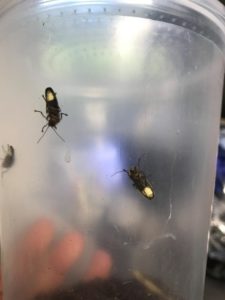
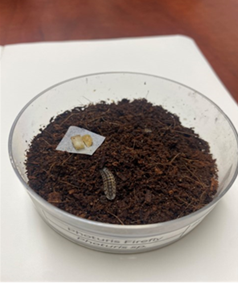
On June 11, 2024, our fourth adult firefly emerged from our 2022 collection, in difference to the ones last year that came from the 2021 collection.
To the best of our knowledge, we are the first to have successfully reared a male and females of a Coloradan species of firefly from eggs to adulthood. This is a critical first step in long-term conservation efforts to help protect and support our native species of fireflies in the Front Range and beyond. The adults that pupated in 2023 lived for around 2 weeks (normal lifespan for fireflies, most of their lives is underground as larvae). We took pictures of them and video footage of their lighting patterns in the darkness. When they die, they are store in a freezer until further genetic analyses with potential research collaborators.
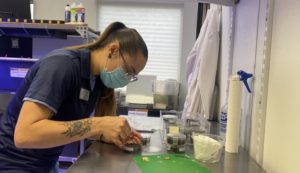
On June 14, 2025, we had our fifth firefly emerge as an adult under human care! Reared in 2022, “Georgia” is the first firefly in Butterfly Pavilion history to successfully pupate after spending three full years as a larva. With patience, precision, and dedication, our team continues to learn more about these remarkable insects and how to protect their populations for future generations.
On June 18, 2025, our team returned to the field where we collected 55 adult fireflies—10 females and 45 males. Each female is housed separately with her own group of four males where they will hopefully mate and lay their own eggs. Their offspring will begin their journey through our specialized care and rearing program as part of our ongoing conservation efforts. Georgia, our newly emerged adult firefly, was introduced to 5 males in her enclosure. We are hoping that this will potentially increase breeding success due to an increase in mate choice. It is our goal for Georgia to mate in the lab and that the other individuals will also mate if not previously mated in the wild. This will ensure that individuals collected will lay eggs under our care that we can then rear to adulthood and further collect data on their life cycle.
Why does anyone care?
Besides providing fascinating summer lightshows for humans, fireflies are an indicator species for wetland habitats. Their health and survivability indicate the overall health of an ecosystem.
Rearing a species to adulthood allows us to fully understand their life history to better support conservation efforts driven by scientific data. Studying their needs in a lab setting allows us to better concentrate conservation efforts on their needs for food, shelter, and overall habit
Become a community scientist and help Butterfly Pavilion track firefly populations around Colorado!



